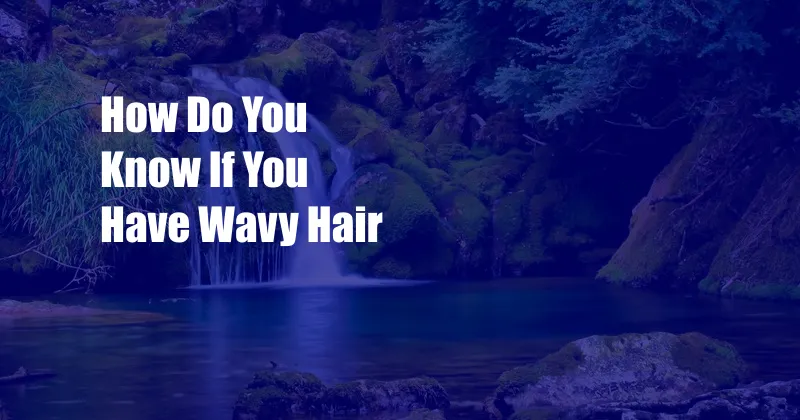
How to Determine if You Have Wavy Hair: A Comprehensive Guide
Have you ever stared at your hair, perplexed by its enigmatic texture? If you find yourself somewhere between poker-straight and tightly coiled curls, you may have wavy hair. This captivating hair type exhibits a unique combination of loose curls and gentle waves, but it can be challenging to pinpoint its exact nature.
Embrace your hair’s individuality and embark on a journey to unravel its true essence. Whether you’re trying to define your hair’s personality or simply curious about its intricacies, this article will guide you through the telltale signs of wavy hair.
What is Wavy Hair?
Wavy hair is a hair texture characterized by its subtle S-shaped waves. It falls between straight and curly on the hair spectrum. Wavy hair is often described as having more volume and movement than straight hair but less definition than curly hair.
The Defining Characteristics of Wavy Hair
Identifying wavy hair requires a keen eye and an understanding of its unique traits. If you’re unsure whether your hair qualifies as wavy, consider the following characteristics:
- Loose Waves: Wavy hair exhibits loose, flowing waves that are not tightly coiled. These waves tend to be more pronounced when the hair is wet or air-dried.
- Volume and Movement: Wavy hair has a natural bounce and volume, creating a fuller and more dynamic appearance.
- Frizz and Tangling: Wavy hair is prone to frizz and tangling, especially in humid environments. This is due to the hair’s tendency to lose moisture quickly.
- Multiple Textures: Wavy hair often exhibits multiple textures throughout its length. Some sections may be more wavy, while others may have straighter or curlier segments.
Subtypes of Wavy Hair
Within the realm of wavy hair, there exists a diverse range of subtypes, each with its own unique characteristics. Understanding these subtypes can help you tailor your hair care routine accordingly:
- Type 2A: This subtype is characterized by loose, barely noticeable waves that are visible when the hair is wet or air-dried.
- Type 2B: Slightly more defined than Type 2A, Type 2B hair exhibits more pronounced waves that are visible even when dry.
- Type 2C: The most defined of the wavy hair subtypes, Type 2C hair has distinct, S-shaped waves that are visible even when styled straight.
Expert Tips for Managing Wavy Hair
Embracing your wavy hair’s beauty requires a well-informed approach. Incorporate these expert tips into your hair care routine to enhance its natural qualities:
- Avoid Over-Washing: Washing your wavy hair too frequently can strip it of its natural oils, leading to dryness and frizz. Aim to wash your hair every 2-3 days or as needed.
- Deep Condition Regularly: Deep conditioning treatments nourish and moisturize wavy hair, reducing frizz and enhancing its elasticity.
- Use a Wide-Tooth Comb: Brushing wavy hair with a wide-tooth comb helps to detangle it without causing breakage.
- Embrace Air-Drying: Allow your wavy hair to air-dry whenever possible. This technique helps to preserve its natural texture and reduce frizz.
FAQ on Wavy Hair
Still have questions about your wavy hair? Here’s a handy FAQ to address common queries:
- Q: Can I straighten my wavy hair permanently?
A: While you cannot permanently alter your hair texture, you can use chemical treatments or heat styling tools to create a more straightened look. - Q: Why does my wavy hair get frizzy?
A: Frizz occurs when wavy hair loses moisture. This can be due to factors such as over-washing, harsh hair products, or environmental humidity. - Q: Can I use a diffuser to style my wavy hair?
A: Yes, using a diffuser attachment on your hair dryer can help enhance your wavy hair’s natural texture and reduce frizz.
Conclusion
Unveiling the secrets of wavy hair is a journey of self-discovery and appreciation. By understanding the defining characteristics, subtypes, and expert care tips, you can unlock the full potential of your captivating hair texture. Embrace the unique beauty of your wavy locks and let them shine with effortless style.
Are you fascinated by the intricate world of hair textures? Share your thoughts and experiences in the comments below. Let’s continue the conversation and explore the boundless beauty of all hair types together.